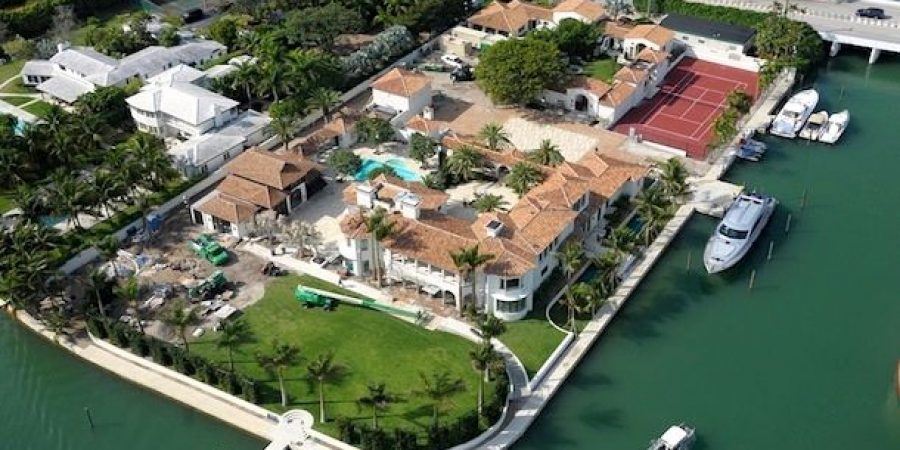A cursory online search for Bill Dean will yield a bevy of blondes and an impression of a man who understands Southern hospitality; possibly a bit too well. One needs to dig a little deeper to discover an unexpected ideology of his: Bill Dean is a bit of a preservationist. Dean owns two significant historic homes: the Robert Dodge House in Georgetown, and the Sebastian Spering Kresge home in Miami Beach. Both have undergone extensive- and expensive- renovations, with Dean putting as much as 4 times the purchase price into the work. In an interview with Hope Gainer for the Huffington Post, Dean explained “You can save a lot of money with a bulldozer, but the reality is you can’t build a historic home.”
The Robert Dodge House is one of two villas designed for the Dodge brothers by Andrew Jackson Downing and his architectural partner Calvert Vaux around 1850. The two homes are in the Italianate style and have the studied asymmetry, irregularity of outline and silhouette, and numerous other features (hood molds, canopies, balconies, etc.) of the style. They both sit on plots that were deeded as part of the ‘Rock of Dumbarton’ tract, which runs along now Q Street up 28th, (past Evermay) to the Oak Hill Cemetery and over to 30th and R at Dumbarton Oaks. Although they have been greatly altered through the years, both were published by Vaux in his Villas and Cottages (1857) providing a wonderful reference to the original structures.
It’s fitting that Bill Dean should have a home built by a fellow engineer. Robert Perley Dodge was born in 1817, the son of Francis Dodge, a prominent merchant and shipper in Georgetown. He attended Princeton University. In only two years he graduated fifth in a class of seventy-six. He then entered the School of Engineering in Kentucky where he completed his major course of study in six months. Dean is the chief executive officer and majority owner of M.C. Dean, an electrical-systems engineering firm in Dulles. The company was founded in 1949 by his grandfather Marion and handed off to his father, Casey, in 1978, then, in 1997, to a 32-year-old Bill.
An article in The Washingtonian retells that Bill joined the firm full-time in 1990, two years after graduating with an engineering degree from North Carolina State. “My dad said, ‘There’s no reason for you to come here and learn what I do, because I’m already doing that. (Referring to the company’s bread and butter- cable and wiring work.) ‘Go do something new,’ ” Dean recalls. And so he did. Dean pushed the company into high tech, often applying his degree to design new systems himself and then writing the proposals needed to capture the business. He hired some of his engineering friends from college, and one friend who’d graduated from MIT, to help.
The first contract Dean landed was to upgrade the IT infrastructure at the Library of Congress, digging out its old telecommunications and electrical networks and installing a new, high-speed network using fiber-optic cables. The contract gave M.C. Dean a marquee client. The company has since expanded rapidly, growing from a 150-person outfit to a 3,000-person firm that’s done business in more than 40 countries and makes about $700 million a year, roughly half of which comes from federal contracts.
After purchasing the property in 2003, Dean spent more than the purchase price to restore and renovate the property, adding a gourmet kitchen, rooftop patio, and a custom-built bar in the basement and renovating a formal living room, a side parlor, the four bedrooms, and his home office. Most of these rooms, with their wood trim, brick fireplaces, and crystal chandeliers, resemble what you’d expect in a 164-year-old home. In the office, Dean’s dark-wood desk faces a portrait of George Washington, a replica of Gilbert Stuart’s “The Athenaeum Portrait,” that Dean, an avid reader of history, specifically requested of his designers.
The Washingtonian reports that Dean’s remodeling also added a sub-basement stuffed with fiber-optic data cabling, computers, and failsafe power systems. A sound system runs through nearly every room in the house, and there are hookups for high-def TVs embedded in control panels on many walls. (Dean can also control the home’s major electrical functions from an app on his smartphone).
Kmart founder Sebastian Spering Kresge’s Mediterranean Revival Miami Beach estate would be a much larger scale renovation. Purchased in 2009 for 8.9 M, Dean invested an additional $34 million to renovate, restore, and add to the 18,100 square foot Miami Beach property. Sitting on a plum corner lot on 2.5 acres with 670 feet of water frontage, it’s the most expensive single-family renovation ever in Miami Beach.
The original house, built in 1937, was a six bedroom, eight bathroom house designed by Austrian–born Carlos B. Schoeppl. Schoeppl came to Florida in 1927 where he established an architectural practice in both St. Augustine and Jacksonville from 1927 to 1929. While in Jacksonville, Schoeppl designed some of the earliest Art Deco buildings in the City including the Downtown Chevrolet Building at 1100 North Main Street. By 1929, Schoeppl had left Jacksonville for Miami, where he had joined in partnership with Arnold Southwell in 1932. During their partnership, Schoeppl designed 7 prominent residences on La Gorce, Sunset, and Indian Creek, and several local businesses. While he was skilled in the highly sought after Mediterranean Revival style, as illustrated in the Kresge Estate, his passion was the up-and-coming and edgier Streamline Moderne.
Newly dubbed Terra Veritatus, the estate now has 15 bedrooms, 20 full baths, six half baths, and two kitchens in the main house. It features a “Spa Wing”, a lushly landscaped poolside beach club and cabanas, a breakfast porch that floats above a lap pool, a Venetian pool, and a rooftop deck with impressive views of Miami Beach. Additional amenities include a tennis court, volleyball court, sports lawn, four outdoor hot tubs and spa, one cold-plunge pool, three fountains and waterfalls, seven car garage and on-site parking for several dozen cars. In all, there is the main house, three guest cottages, a spa building, a nightclub, and pool house with cabanas.
“The challenge was to pay homage to the 1930’s architecture and bring in some amazing new things, “explained Michael Capponi, the General Contractor for the project. The compound is a combination of old-world meets new. The house is state-of-the-art. There’s a central control system, which manages all of the property’s video, audio and electrical systems; everything is controlled by individual iPods. “You press a button here for the satellite radio at the fountains, and know if you go down to the fountains now, you’ll hear the radio,” said engineer Alex Vasquez. And there’s a geothermal energy system that runs off the power of the canal system, one of the most cutting-edge, green-living components in existence.
Locals are calling Dean the Jay Gatsby of Miami Beach, bringing the story back around to the playboy millionaire image and lavish parties held on the estate. Dean remarked in the Ganier interview that his “goal was to have a great home for the rest of my life. I was looking to build to enjoy initially as a bachelor, but also to be an awesome place for family.” Maybe when that family arrives, Terra Veritatus will seem less of a bachelor’s paradise. In any event, it will still be there for future generations thanks to his substantial investment in its preservation.



